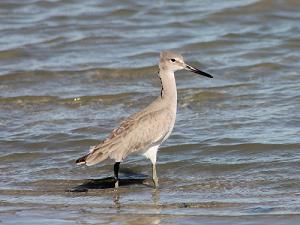Adam Hannuksela
To increase waterbird monitoring and knowledge in southern Sonora on the Sea of Cortez, as well as build capacity for local biologists and students.

Tringa semipalmata, Willet, Playero pihuihui ©ERA. Navopatia, Sonora. 2013.
The coast of Southern Sonora on the Sea of Cortez is an important wintering and migratory stopover area for dozens of species of aquatic birds. Despite this fact, little is known about the migration phenology and overwintering abundance of waterbirds in the region. Habitats include; beaches, small islands, mangroves, mudflats, and open water. This project will address this issue by gathering baseline data on all waterbirds in the study areas. All species of seabirds, shorebirds, waders, ducks, and others will be counted throughout the wintering and migratory period. Previous studies have focused on a single date in the winter, or flyovers that can only capture very broad abundance data for size classes, rather than specific species, of aquatic birds. This is the first time in history that aquatic birds will be monitored throughout the wintering and migratory periods.
With increased industrial agriculture and aquaculture in the region, and associated fertilizer and pesticide use, the possible effects on the area’s aquatic birds is poorly understood. Future effects of climate change may also effect southern Sonora’s coastlines. Gathering baseline data for the entire winter period is important to understand possible future impacts from human activities. Data gathered will be shared within the Avian Knowledge Network (AKN) and made available to all interested parties. The final report will be made available to any possible stakeholders and help inform land and wildlife managers. The Alamos Wildlands Alliance has been working in the area since 2002. Making observations and opportunistically surveying waterbirds, this project will also include all previously collected data. We operate the Navopatia Field Station, where visiting biologists will be housed and trained.
A large component of this project is building capacity of regional biologists and students interested in aquatic bird ecology and monitoring. Small groups will be invited to the Navopatia Field Station to stay for 3-4 day workshops that will focus on ornithology, natural history, and monitoring techniques. Very experienced Mexican nationals were hired to assist in training, field work, and data analysis. After completing the workshops, participants will be able to assist current and future large and small scale monitoring efforts, throughout the region.